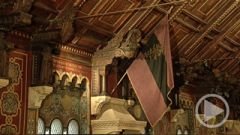Wartburg - Deutsche Hochkultur
Sängerkrieg, or Courtly Culture and the Greatest Poets
Most castle keeps were not known for their cosy comfort. But the Ludowings lived well. The Wartburg even had an under-the-floor heating system. Remnants of it have been found in front of the north wall.
The next room was also the site of unheard-of luxury. Even back then, every single room in the castle had a fireplace. Some even had glass in the windows. It was probably here, at the centre of the building, that communal meals were enjoyed. The men came from the knights’ room on the left and the women from the right, from the ladies’ apartments. The beams holding up the ceiling are original to the period. Dendrochronological analysis has shown that the oaks were felled in 1162 and used in the same year.

But the Wartburg was more than just a stronghold of luxury living. From the dining hall, the only surviving medieval staircase takes you up to the Singers’ Hall. This was the castle’s representational public hall before a storey was added to the building in 1170.
The arched area over the old staircase creates an elevated platform. And Hugo von Ritgen was convinced that it was here that the most famed legend of the Wartburg took place. Around the year 1200, the sophisticated arts of court were in full bloom. And under Landgrave Hermann, the Thuringian court was considered the most cultivated in all the empire.
“During his time, Minnesong flourished in German countries and was practiced and beloved of princes and nobles, and Prince Hermann gathered many singers to his illustrious court at the Wartburg.”
That was Ludwig Bechstein telling of the great War of Minstrels. The six most celebrated stars of the Middle Ages gathered here, including Walther von der Vogelweide, Wolfram von Eschenbach and Master Biterolf. Their songs praised the landgrave’s appreciation of art. With one exception – Heinrich von Ofterdingen. He came from Austria and praised not Hermann, but his own duke, Leopold.

And that got him into trouble. A dispute erupted and, in the end, everyone demanded Heinrich’s head. As we see, the hangman was already standing by with a noose when Heinrich threw himself at the landgravine’s feet to plead for mercy. She granted him a reprieve and ordered that the competition be repeated.
The following year, Heinrich von Ofterdingen brought along a referee. The great sorcerer Klingsor from Hungary floats in on a cloud. He himself was a minnesinger and mediated the dispute. The parties came to an amicable agreement that it was a dead heat.
That spirit of amicability was no doubt facilitated by a prophecy made by Klingsor. He foretold that on the day of the second war of minstrels, a daughter would be born to the king of Hungary and she would become the new landgravine. The idea of the daughter of a king in Thuringia sent excitement raging inside the fortress walls.
Landgrave Hermann, grandson of the first Louis, was in fact famous as a patron of the arts. The most important German lyric poet of the Middle Ages, Walther von der Vogelweide, was a guest at his court. And Wolfram von Eschenbach most probably actually lived here for some time – his “Parzival” is even today considered one of the greatest literary works in the German language.






